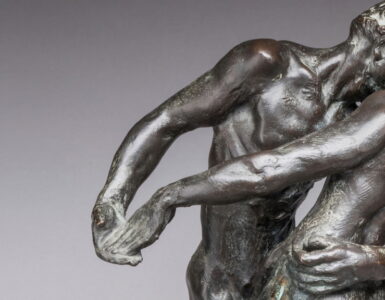
Okay, the first thing you need to know about this current exhibit at the Getty Center (the one high on the hill) is that you will not see any sculptures actually made by or attributed to the famous 15th century Italian artist, inventor and creator, Leonardo da Vinci.
Rather, this impressive exhibition places a special focus on inspiration and invention.
Born April 15, 1452, Anchiano, near Vinci, Republic of Florence [now in Italy], the son of a landowner and a peasant, Leonardo da Vinci received training in painting, sculpture, and mechanical arts as an apprentice to Andrea del Verrocchio. He died May 2, 1519, Cloux [now Clos-Lucé], France.
Leonardo da Vinci was an Italian polymath, that is to say he was a person with superior intelligence whose expertise spanned a significant number of different subject areas. His vast breadth of interests and talents included: painter, sculptor, architect, musician, scientist, mathematician, engineer, inventor, anatomist, geologist, cartographer, botanist and writer. Leonardo has often been described as the archetype of the Renaissance man, a man whose unquenchable curiosity was equaled only by his powers of invention.
Da Vinci was an apprentice in the studio of Verrocchio where sculpture, as well as painting, was an everyday activity. Records show that he worked as a sculptor.
While there exists ample evidence, in historical accounts as well as in the artist”™s letters and notebooks, that da Vinci created works of sculpture and received several monumental commissions, there are no surviving works that can be definitively attributed to him. Hence nowhere can you see a large work of sculpture that has been positively identified as being the work of Leonardo da Vinci.
Considering it is believed that the Vatican keeps a vast majority of da Vinci”™s treasures under lock and key, naturally it is always exciting when we can catch a glimpse of some of this great man”™s great works, even just sketches or plans of sculptures, if not the sculptures themselves.
When you first enter the West Pavilion of The Getty Museum, you are confronted by a massive image of a prancing horse representing Il Cavallo, the huge 24-foot bronze equine statue Leonardo da Vinci planned but never saw to its completion. Commissioned in 1482 by Lodovico Sforza, the Duke of Milan, in honor of his father Francesco, the massive 70-ton bronze monument took Leonardo seventeen years of research and planning. When the full-scale clay model was finally ready to be cast in a single operation in 1499, all the necessary bronze was taken to make cannons for an imminent war against the King of France.
Da Vinci’s plan for the largest equestrian statue in the world, if completed, would have probably been his greatest legacy, possibly more famous than his painting The Last Supper or any of his other artistic creations.
Nevertheless, this exhibition includes various drawings by the artist of his inventions and planning (many of which are borrowed from the collection of Queen Elizabeth II) as well as one of his paintings, of which there are fewer than a dozen in the world. The drawings highlight his working method of sketching ideas and notes for his artistic compositions and inventive devices, which, sadly, have not survived.

Above all, this exhibition is a showcase for the recent restoration of three monumental bronze statues from 1511 by da VinciӪs younger colleague, Giovan Francesco Rustici. Removed for conservation from the fa̤ade of the Baptistery in Florence several years ago, these magnificent pieces had never been seen outside of the city until their display late last year at AtlantaӪs High Museum of Art.
The trio of giant bronze statues, depicting John the Baptist, a Pharisee and a Levite, are impressive indeed, with their expressive gazes, gestures and draped clothing.
Leonardo and Rustici worked closely together and Rustici was immersed in Leonardo’s studio practice. Because of their collaborations and similar aesthetic, Rustici’s work is considered the best echo of Leonardo’s lost activity as a sculptor.
The depiction of the three elegant and somber figures, the variety of their drapery and their anatomical realism give credence to an opinion related by Giorgio Vasari that “Leonardo worked at the group with his own hand, or that he at the least assisted Rustici with counsel and good judgment.”
In the absence of any securely attributed sculptures by Leonardo himself, these works, along with his surviving drawings, give us a glimpse of Leonardo’s sculptural accomplishments. This exhibition is worth seeing for the trio of monumental bronzes alone, even if they are not by the legendary artist himself.
Leonardo da Vinci and the Art of Sculpture: Inspiration and Invention is organized by the High Museum of Art, Atlanta in association with the J. Paul Getty Museum, Los Angeles. The exhibition is supported by an indemnity from the Federal Council on the Arts and Humanities. The J. Paul Getty Museum is also grateful for the support of the Istituto Italiano di Cultura and the Italian Consulate General, Los Angeles.
The exhibition runs until June 20th 2010
LEONARDO DA VINCI AND THE ART OF SCULPTURE: Inspiration and Invention
The J. Paul Getty Museum at the Getty Center
1200 Getty Center Drive, Los Angeles
Open:
Tuesday-Friday 10:00 a.m.-5:30 p.m.
Saturday 10:00 a.m.-9:00 p.m.
Sunday 10:00 a.m.-5:30 p.m.
Monday CLOSED
Closed Mondays and on January 1, July 4 (Independence Day), Thanksgiving, and December 25 (Christmas Day).
Admission to the Getty Center and to all exhibitions is FREE“”no tickets or reservations are required for general admission.
Public Transportation
Get to the Getty Center via public transport! The Getty Center is served by Metro Rapid Line 761, which stops at the main gate on Sepulveda Boulevard. To find the route that is best for you, call (800) COMMUTE or use the Trip Planner — the Web site of the Los Angeles County Metropolitan Transportation Authority.
Parking is $15 per car. Entry is FREE after 5:00 p.m. for the Getty Center’s evening hours on Saturdays (when they are open until 9:00 p.m.), as well as for all evening public programming, including music, film, lectures, and other special programs held after 5:00 p.m.
Parking reservations are neither required nor accepted. For more parking information, see hours, directions, parking.
and frequently asked questions.
Review by Pauline Adamek








[…] the original post here: Da Vinci and the Art of Sculpture exhibition at the Getty : ArtsBeatLA By admin | category: federal da | tags: also-grateful, arts, council, cultura, getty, […]
A bit of brilliant data you have posted in this article.
A lot of great content you’ve listed right here.
I’ve noticed your website a while ago, just recently did i start noticing it more and more. Very useful information, thank you and keep it coming.
Great info! I recently came across your blog and have been reading along. I thought I would leave my first comment. I don”™t know what to say except that I have enjoyed reading. Nice blog. I will keep visiting this blog very often.
Hmm it appears like your blog ate my first comment (it was super long) so I guess I’ll just sum it up what I wrote and say, I’m thoroughly enjoying your blog. I too am an aspiring blog blogger but I’m still new to the whole thing. Do you have any tips and hints for novice blog writers? I’d definitely appreciate it.